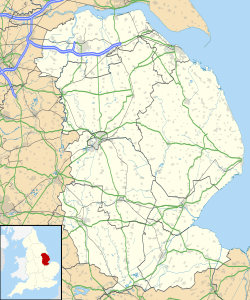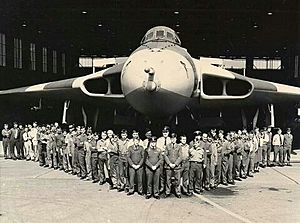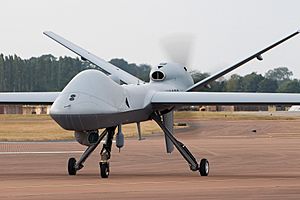RAF Waddington facts for kids
Quick facts for kids RAF Waddington
|
|||||||
|---|---|---|---|---|---|---|---|
| Near Waddington, Lincolnshire in England | |||||||
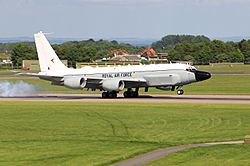
The RAF's first Boeing RC-135W Rivet Joint arrives at RAF Waddington in November 2013
|
|||||||
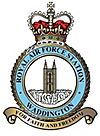
For Faith and Freedom
|
|||||||
|
Shown within Lincolnshire
|
|||||||
| Coordinates | 53°10′21″N 000°31′51″W / 53.17250°N 0.53083°W | ||||||
| Type | Main Operating Base | ||||||
| Area | 391 hectares (970 acres) | ||||||
| Site information | |||||||
| Owner | Ministry of Defence | ||||||
| Operator | Royal Air Force | ||||||
| Controlled by | No. 1 Group (Air Combat) | ||||||
| Condition | Operational | ||||||
| Site history | |||||||
| Built | 1916 | ||||||
| In use |
|
||||||
| Garrison information | |||||||
| Current commander |
Group Captain Mark Lorriman-Hughes | ||||||
| Occupants | See Based units section for full list. | ||||||
| Airfield information | |||||||
| Identifiers | IATA: WTN, ICAO: EGXW, WMO: 03377 | ||||||
| Elevation | 70.1 metres (230 ft) AMSL | ||||||
|
|||||||
Royal Air Force Waddington, also known as RAF Waddington, is a Royal Air Force (RAF) base. It is located next to the village of Waddington in Lincolnshire, England. This is about 4 miles (6.8 km) south of the city of Lincoln.
RAF Waddington is the main centre for the RAF's Intelligence, Surveillance, Target Acquisition and Reconnaissance (ISTAR) operations. This means it's where they gather important information using special aircraft. The base is home to planes like the Shadow R1 and the RC-135W Rivet Joint. It also operates the RAF's MQ-9 Reaper drones. Since October 2022, the famous Red Arrows aerobatic team has also been based here.
Contents
History of RAF Waddington
Early Days: First World War
RAF Waddington first opened in 1916 as a training base for the Royal Flying Corps. Young pilots, including some from the US Army, learned to fly different types of aircraft here. When the Royal Air Force was formed on April 1, 1918, the station became part of it. It closed down in 1920 for a period of care and maintenance.
Between the World Wars
Before the Second World War, the Waddington site was chosen to become a large base for bomber aircraft. It reopened as a bomber base on March 12, 1937. Squadrons like No. 50 Squadron and No. 44 Squadron moved in with their planes, including the Handley Page Hampden and Bristol Blenheim.
Second World War Operations
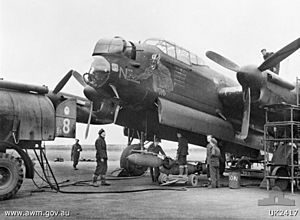
At the start of the Second World War, RAF Waddington was home to Hampden bombers. These planes were involved in some of Britain's first attacks on German naval targets. Waddington's squadrons also played a key role in 1940, attacking barges that were being gathered for a possible invasion of Britain.
In November 1940, Waddington was the first base to receive the new Avro Manchester heavy bomber. Later, No. 44 Squadron RAF was the first in the RAF's Bomber Command to fly the famous Avro Lancaster bomber from Waddington in March 1942.

On April 17, 1942, seven Lancasters from No. 44 Squadron took off from Waddington for a daring bombing raid on a U-boat engine factory in Germany. Many other squadrons, including those from the Royal Australian Air Force (RAAF) and Royal Canadian Air Force (RCAF), also operated from Waddington during the war.
Cold War Era

During the Cold War, RAF Waddington became an important base for Avro Vulcan V-bomber aircraft. These large bombers were part of Britain's nuclear defense. No. 83 Squadron was the first in the RAF to get the Vulcan in May 1957. Waddington continued to be a Vulcan base until 1984.
In August 1960, the base developed a quick way to lay a foam carpet on the runway for planes that had to land without their wheels. This made emergency landings much safer.
Falklands War Contribution
During the Falklands War in 1982, RAF Waddington played a crucial role in Operation Black Buck. Three Vulcan B2 aircraft and their crews from Waddington took part in very long-range bombing raids on Port Stanley airfield in the Falkland Islands. These missions were very complex and involved many other tanker aircraft to refuel the Vulcans in the air.
Recent History: 1990s and 21st Century
In July 1991, No. 8 Squadron moved to RAF Waddington and started using Boeing E-3 Sentry aircraft, which are used for airborne early warning.
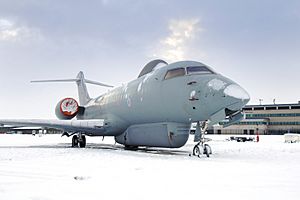
In 2014, the runway at RAF Waddington was closed for a major rebuild. This project took over two years to complete and helped the runway last for another 25 years.
More recently, in April 2020, No. 216 Squadron was reformed at Waddington. This unit is special because it tests new drone swarm technology for the future. In 2020, a new flight simulator training facility was completed, allowing UK and US aircrews to train together in realistic scenarios.
In 2021, the Sentinel R1 aircraft were retired, and the E-3D Sentry planes were also replaced. No. 8 Squadron moved to another base to use the new Wedgetail AEW1 aircraft. In 2022, the RAF Aerobatic Team moved to Waddington from RAF Scampton.
What RAF Waddington Does Today
Command and Leadership
The base is led by a Group Captain. Since January 2022, Group Captain Mark Lorriman-Hughes has been the Station Commander.
ISTAR Operations
RAF Waddington is the main centre for the RAF's Intelligence, Surveillance, Target Acquisition and Reconnaissance (ISTAR) operations. This means it's where they gather important information using special aircraft. The base is home to planes like the Shadow R1 and the RC-135W Rivet Joint. It also operates the RAF's MQ-9 Reaper drones.
The No. 1 Intelligence Surveillance Reconnaissance Wing was formed in 2016. Its main headquarters are at Waddington, and it combines different units that collect and analyze intelligence.
Expeditionary Air Wing
No. 34 Expeditionary Air Wing (EAW) was created at Waddington in 2006. This unit is designed to be quickly sent to different parts of the world as a complete air force team.
Other Units at Waddington
RAF Waddington is also home to the RAF Waddington Voluntary Band, which is one of seven volunteer bands in the RAF.
Units Based at RAF Waddington
Many important flying and non-flying units are based at RAF Waddington:
Royal Air Force Units
|
British Army Units
Civilian Units
|
Future Plans
Protector RG1 Aircraft
The General Atomics MQ-9B drone, which the RAF will call the Protector RG1, will be based at RAF Waddington. This is a remotely piloted aircraft system (RPAS). No. 31 Squadron is expected to be the first to fly the Protector. New buildings, including a hangar and crew accommodation, are being built at Waddington for these new aircraft.
Station Heritage
Station Badge and Motto
The badge for RAF Waddington shows Lincoln Cathedral rising through the clouds. The motto below it is 'For Faith and Freedom'.
Gate Guardians
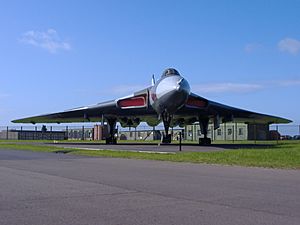
The main gate guardian at RAF Waddington is an Avro Vulcan bomber, XM607. This particular Vulcan was one of the three that took part in the famous Operation Black Buck raids during the Falklands War in 1982. XM607 was based at Waddington and was flown by pilots like Flight Lieutenant Martin Withers. After it was retired in 1984, it was kept as a display aircraft at the base.
Another aircraft, a Hawker Hunter F.6A, also acts as a gate guardian outside the No. 8 Squadron buildings.
Waddington International Air Show
The RAF Waddington International Air Show started in 1995. It became the largest air show organized by the Royal Air Force. The show usually took place on the first weekend of July and attracted over 140,000 visitors. Its main goal was to help people understand the RAF and its role. Most of the money raised went to charities that support RAF personnel and their families. Since 1995, the air show raised almost £3 million for charities.
In 2015, the air show was cancelled because the runway at the base needed to be rebuilt. After a review, it was decided that the air show would not continue at Waddington due to security and operational reasons. These reasons were mainly linked to RAF Waddington being a base for Reaper drones.
In 2016, it was announced that the air show would move to RAF Scampton, with hopes of bringing it back in 2017.
Images for kids


